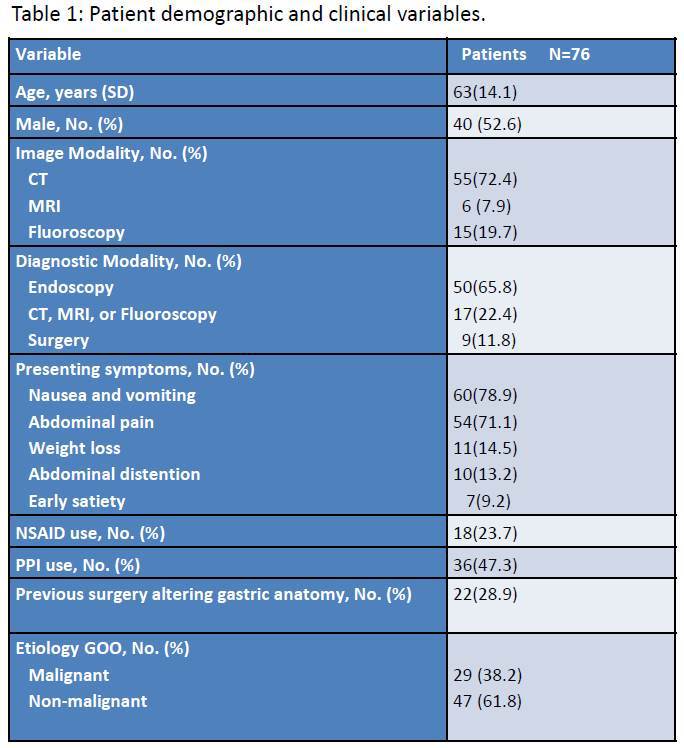|
Back to 2018 Posters
PANCREATIC CANCER MOST COMMON CAUSE OF MALIGNANT GASTRIC OUTLET OBSTRUCTION AT A TERTIARY REFERRAL CENTER: A 10 YEAR RETROSPECTIVE STUDY
Andree Koop*1, William C. Palmer1, Karl Mareth1, Caroline M. Burton2, Andrew Bowman1, Fernando F. Stancampiano1
1Mayo Clinic Florida, Jacksonville, FL; 2Hospital Internal Medicine, Mayo Clinic, Rochester, MN
Introduction: Gastric outlet obstruction (GOO) is a clinical syndrome with substantial morbidity and mortality characterized by mechanical obstruction to gastric emptying and symptoms of abdominal pain, early satiety, nausea, and vomiting. The primary underlying etiology has changed in recent decades, from peptic ulcer disease (90% of patients) in the 1960s to malignancy (50-70% of patients) in the 1990s with the development of acid suppression medications. Gastric cancer is the most common malignant etiology reported worldwide, although the overall incidence of gastric cancer is decreasing in the United States. The goal of this study was to update the literature on the spectrum of etiologies, clinical characteristics, and management of GOO in the 21st century.
Methods: This was an IRB-approved retrospective study of all patients with GOO at a tertiary care referral center from January 2006 to December 2015. Included patients were age 18 years or older and had both clinical symptoms of GOO and findings of GOO on radiologic imaging. The etiology of GOO was confirmed in all patients. Data collected on study patients included demographic information and management. Associations between clinical characteristics and the underlying etiology of GOO (benign versus malignant) were performed with a multivariable regression model.
Results: Seventy-six unique patients were included in the study, and patient characteristics are listed in table 1. The etiologies of GOO and management are listed in table 2. The underlying etiology was benign in 62% of patients and malignant in 38%. The most common malignancy was pancreatic adenocarcinoma 13 patients (17%) and gastric adenocarcinoma in 5 patients (7%). Of the non-malignant etiologies, peptic ulcer disease was the most frequent in 13 patients (17%). In multivariable regression analysis, there were no significant associations between patient characteristics and the etiology of GOO including age, sex, clinical symptoms, body mass index, or medications including NSAIDs and PPIs. Ten of twenty-nine patients with malignancy underwent endoscopic stenting versus only 1/47 patients with a benign etiology. Non-malignant GOO was managed most often with conservative medical therapy (17/47 patients) and endoscopic dilation (13/46 patients).
Conclusion: Malignancy remains a frequent etiology of GOO, and should be suspected until proven otherwise. We identified pancreatic adenocarcinoma as the most common malignant etiology, which differs from prior literature describing gastric cancer as most frequent. This may reflect overall changes in the incidence of gastric cancer in Westernized countries. The underlying etiology has important treatment implications including endoscopic therapy.


Back to 2018 Posters
|


